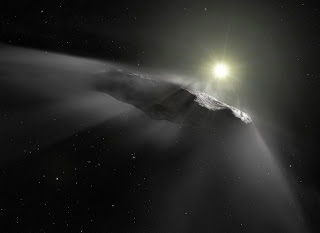 |
| Interstellar objects like Oumuamua could be the source of life as we know it. ESA/Hubble, NASA, ESO, M. Kornme |
Topics: Carl Sagan, Exoplanets, SETI, Space Exploration, Star Trek
Note: Star Trek had an episode titled "Space Seed" with Ricardo Montalbán and his portrayal of Khan Noonien Singh. Also, since I've used Panspermia before, that was the rationale for the post title (with proper attribution, of course).
Are we truly earthlings? Is terra firma unequivocally the birthplace of humanity?
Maybe not. A new paper by a trio of Harvard University researchers argues that we all might be immigrants from deep space, brought to Earth via a mechanism called panspermia.
While the conventional wisdom from biologists has long been that life on Earth began on Earth, science fiction isn't so fuddy-duddy. “Prometheus,” Ridley Scott’s 2012 prequel to the blockbuster “Alien” franchise, is one of many films positing that our planet was seeded by extraterrestrial life.
In the movies, aliens use some sort of engineered transportation system to get here — rockets or wormholes, for example. Panspermia makes no such technical demands. Here’s the basic idea: A meteor slams into a planet where life exists, and the collision lofts into space a microbe-containing dirt clod. The clod eventually slams into another world and infects it with life.
Are germs from outer space the source of life on Earth?
Seth Shostak, Senior Astronomer, SETI Institute
Comments